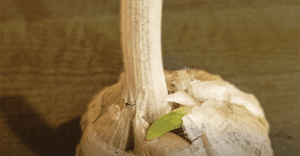By Joyce Amsden
It’s midwinter and you reach into your paper bag of carefully stored garlic. You pull out a bulb and see a sprout emerging from the top.
There is nothing wrong. It is the nature of garlic cloves to sprout at this time of year.

Stored garlic that begins to sprout can be preserved by freezing, dehydrating or storing in vinegar and then refrigerated.
The problem is that over the next weeks the cloves will use up all their food stores to nourish that sprout. By mid-spring, you will be left with dry, empty husks where your delicious garlic once was. Acting now to preserve your garlic by one or more of the following methods will prevent this disappointment.
To preserve garlic in vinegar, separate the individual cloves and peel. Rinse if needed and dry. Place peeled cloves into a glass jar. A canning jar works well for this.
The sprouts are harmless, so don’t be shy about including them. Add enough white or red wine vinegar to cover the cloves by half an inch, and leave half an inch of headspace in the jar as well. Cover and refrigerate for up to four months. Discard if mold occurs.
Note that storing garlic in oil is risky as it provides a low-acid environment where botulism can grow, whether at room temperature or refrigerated. Freezing in oil is safe.
To dehydrate garlic, prepare cloves as above, and then cut in half lengthwise. Dry in your dehydrator at 140 ° F for two hours, and then reduce heat to 130°F until they are brittle.
Or use your oven at its lowest heat. The cloves should snap in two when you bend them. Let cool and pack into an airtight container at room temperature.
You can make garlic powder by grinding in a blender or food processor until fine. Add salt to make garlic salt. Garlic should be powdered only as needed. This allows you to use the snap test to ensure that the garlic is safe for eating.
To freeze garlic, prepare as above. Chop or crush garlic in a bowl, and add just enough olive oil to cover the garlic.
Spoon into an ice cube tray designated for use with herbs. Once frozen, just pop the cubes into a plastic bag, and you will have portioned amounts to pull out and add to the skillet. You also can freeze roasted garlic in ice cube trays.
You might be asking, “Why not plant your sprouting garlic cloves?” Chances are, here in New England, that by the time the ground thaws, the bulbs will be pretty much exhausted and will not grow.
Planting cloves in pots might work, but I have found that transplanted garlic takes a long time to recover. You are better off planting new garlic as early as the ground can be worked.
Spring planting of garlic will work, but it will net you one large, tasty clove instead of growing a bulb with many cloves. For the best garlic harvest, plant in the mid-September or before the ground freezes in the fall.
Joyce Amsden is a UVM extension master gardener intern from Sharon.




